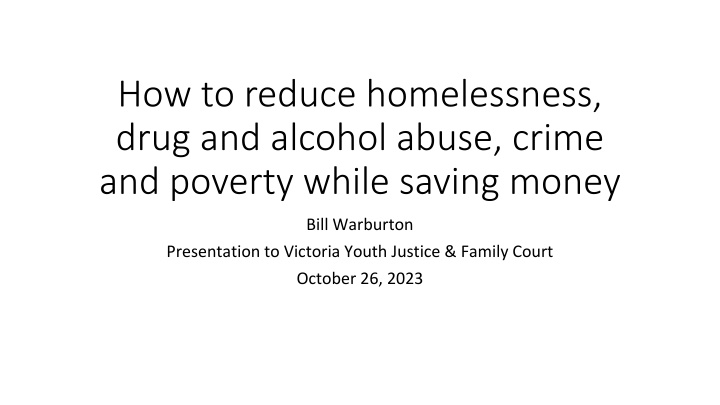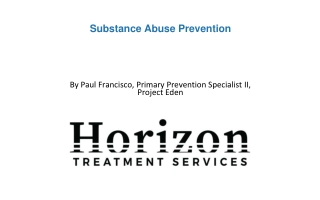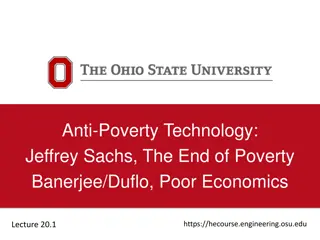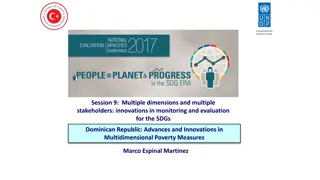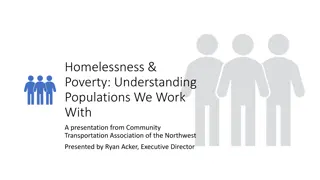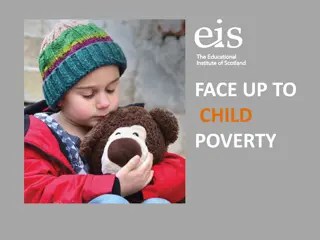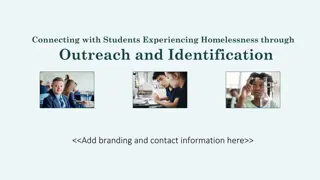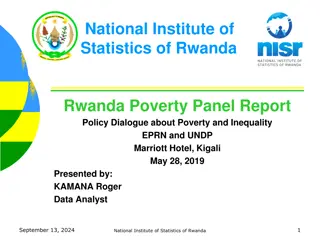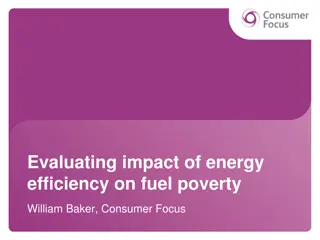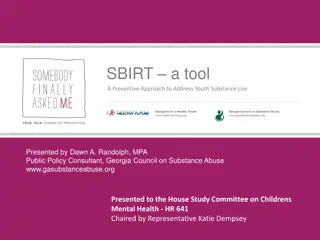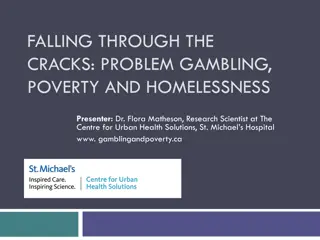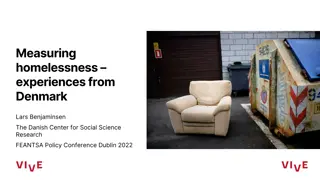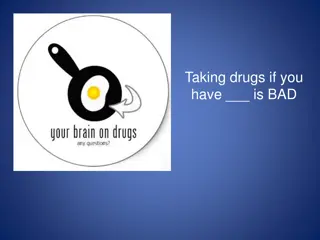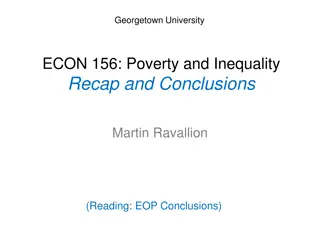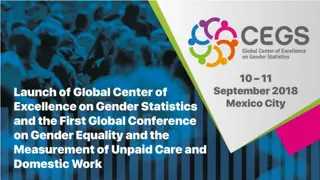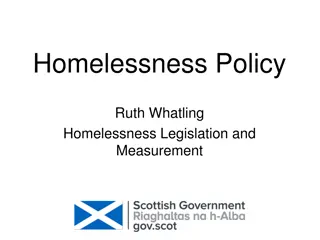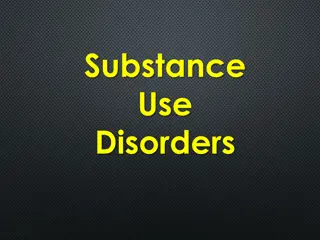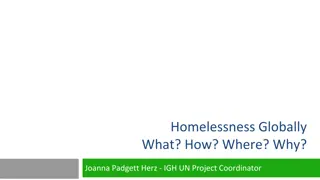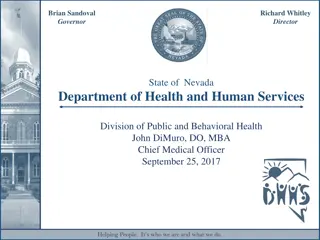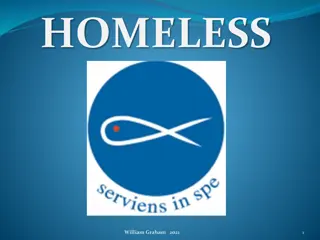Strategies for Addressing Homelessness, Substance Abuse, and Poverty
The presentation highlights the correlation between dropping out of school and issues like homelessness, drug and alcohol abuse, crime, and poverty. By identifying at-risk children early and implementing effective interventions, there is potential to break the cycle and reduce these societal challenges. Independent evaluations are stressed for interventions' effectiveness. Data shows a significant gap in educational attainment and the manifestation of problems among those who don't complete high school. Insights on income assistance reflect the link between poverty and educational attainment.
Download Presentation

Please find below an Image/Link to download the presentation.
The content on the website is provided AS IS for your information and personal use only. It may not be sold, licensed, or shared on other websites without obtaining consent from the author.If you encounter any issues during the download, it is possible that the publisher has removed the file from their server.
You are allowed to download the files provided on this website for personal or commercial use, subject to the condition that they are used lawfully. All files are the property of their respective owners.
The content on the website is provided AS IS for your information and personal use only. It may not be sold, licensed, or shared on other websites without obtaining consent from the author.
E N D
Presentation Transcript
How to reduce homelessness, drug and alcohol abuse, crime and poverty while saving money Bill Warburton Presentation to Victoria Youth Justice & Family Court October 26, 2023
I acknowledge with respect the L k n speaking peoples on whose unceded traditional territory I have lived and worked for the past 40+ years, represented today by the Songhees and Esquimalt Nations.
Agenda Results from our study 1. Result 1: We can identify 2000 10-year-olds who are at extreme risk of poor educational attainment. 2. Result 2: homelessness, drug and alcohol abuse, crime and poverty are primarily manifest among those who have dropped out of school. From the literature 1. There are interventions that are effective and cost-effective 2. When interventions are subjected to independent scientific evaluations, most don t work 3. Success elsewhere doesn t guarantee success in BC Conclusion Try a lot, have independent, rigorous studies of their effectiveness; expand the ones that work.
We can identify 2000 10-year-olds who are at extreme risk of poor educational attainment.
Sample: 1999/2000 to 2005/2006 (about 250,000 students) Less some special needs, those who entered or left the province Hold the 2002/2003 class separate Characteristics: Foundation Skills Assessment scores, Special needs codes Income Assistance history Use of the health care system Family structure and stability Contact with the Ministry for Children and Family Development Linear probability model
69% did not graduate high school Of the 2,000 10-year-olds at extreme risk each year Only 1% graduated on time with an average or better GPA
Homelessness, drug and alcohol abuse, crime and poverty are primarily manifest among those who have not completed high school.
Income assistance (as a proxy for poverty) 25% 77% of total 20% of females who didn t make it to grade 12 received IA in any given month 20% Relative risk ~30 15% Female Relative risk almost 10 Male 10% 5% 0% On time Dogwood English 12 GPA > 3 On time Dogwood English 12 Six year Dogwood English 12 Any Other Six year Dogwood Adult Grade 12 Did not Graduate In 6 years No Gr. 12 Did not Graduate In 6 years Graduation within 6 years
Homelessness 3.5% 82% of total 3.0% 2.5% Relative risk ~60 2.0% Female 1.5% Relative risk ~ 10 Male 1.0% 0.5% 0.0% On time Dogwood English 12 GPA > 3 On time Dogwood English 12 Six year Dogwood English 12 Any Other Six year Dogwood Adult Grade 12 Did not Graduate In 6 years No Gr. 12 Did not Graduate In 6 years Graduation within 6 years
75% of total Corrections 8% 7% 6% Relative risk ~40 5% 4% Female Relative risk ~ 10 3% Male 2% 1% 0% On time Dogwood English 12 GPA > 3 On time Dogwood English 12 Six year Dogwood English 12 Any Other Six year Dogwood Adult Grade 12 Did not Graduate In 6 years No Gr. 12 Did not Graduate In 6 years Graduation within 6 years
Prescriptions related to drug and alcohol treatment 77% of total 2.0% 1.5% Relative risk ~40 Female 1.0% Male Relative risk ~ 7 0.5% 0.0% On time Dogwood English 12 GPA > 3 On time Dogwood English 12 Six year Dogwood English 12 Any Other Six year Dogwood Adult Grade 12 Did not Graduate In 6 years No Gr. 12 Did not Graduate In 6 years Graduation within 6 years
Having a child in care 90% of total 2.0% 1.5% Relative risk ~200 1.0% Relative risk ~ 23 0.5% 0.0% On time Dogwood English 12 GPA > 3 On time Dogwood English 12 Six year Dogwood English 12 Any Other Six year Dogwood Adult Grade 12 Did not Graduate In 6 years No Gr. 12 Did not Graduate In 6 years Graduation within 6 years
Taxes paid and high school graduation 12,000 10,000 Net present value difference is $75,000 8,000 6,000 4,000 2,000 - Average grad Average dropout
Early pathways, though far from indelible, establish either a sturdy or fragile stage on which subsequent development is constructed. National Research Council. 2000.
Three interventions that that are effective and cost-effective
$6.30 return to society for each $1 invested
Thinking Fast, Thinking Slow Project Summary Male high school students in economically disadvantaged areas of Chicago were offered group sessions during the school day to learn how to slow down their decision-making in high-stakes situations. Impact Participation in the program reduced total arrests by 28-35%, violent-crime arrests by 45 50%, and increased high school graduation by 19%. Cost At the time of the study, the intervention cost was estimated to be approximately $1,850 per participant per year, at scale.
The children of treatment group (average age 28) are more likely to be in good health more likely to be employed, less likely to have been suspended from school less likely to be divorced. https://hceconomics.uchicago.edu/ news/research-spotlight-lasting- benefits-perry-preschool- participants-siblings-and-children https://www.nber.org/papers/w29 057
Random Assignment The average value of any variable will be the same for the sample as for the population, provided that the sample is selected randomly. 1689 Jacob Bernoulli
Most new ideas are wrong 50-80% of new drugs fail when subjected to randomized controlled trials (RCT s) 80-90% of new products/strategies conducted by Google and Microsoft have no significant effects when tested in RCT s 70% to 80% of new social interventions subjected to scientific evaluation in the US did not achieve their objectives Different impacts in different sites JTPA Impacts on youth Nurse Family Partnership Pre-K
Interventions that are effective and cost- effective Disruptive kids Tremblay AER 2022 Universal pre-K Boston Gray-Lobe 2022 Abcedarian The Lifecycle Benefits of an Influential Early Childhood Program. Heckman et al Scared Straight,(Petrosino et al. 2013) McCord, Joan. 2003. Cures That Harm Tennessee s pre- kindergarten (Lipsey, Farran, and Hofer 2015)
Summary Results from our study 1. Result 1: We can identify 2000 10-year-olds who are at extreme risk of poor educational attainment. 2. Result 2: homelessness, drug and alcohol abuse, crime and poverty are primarily manifest among those who have dropped out of school. From the literature 1. There are interventions that are effective and cost-effective 2. When interventions are subjected to independent scientific evaluations, most don t work 3. Success elsewhere doesn t guarantee success in BC Conclusion Try a lot, have independent, rigorous studies of their effectiveness; expand the ones that work. Our society can be healthier, wealthier and happier.
